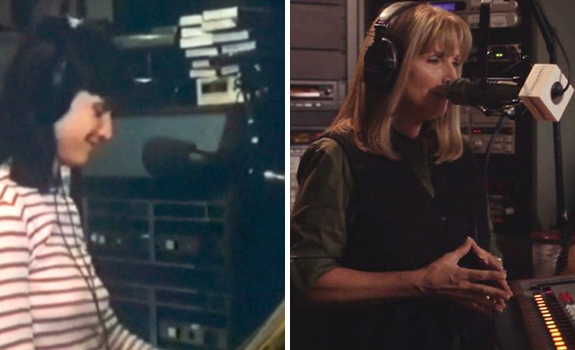
Photo by Allegra Boverman
“I’ve never really had any insecurity or doubt about who I am or what I’ve contributed, or the recognition I deserve…I mean, I’m a DJ in the Rock n Roll Hall of Fame and you don’t get put in there if you suck.”
The DJ is Meg Griffin, and for the legions of Family Guy fans who only know her namesake from the show, she’s not impressed with the character her once family friend Seth McFarland created. “I think the reason he did that with my name, because I do think he’s really snarky, was because I am the only one in the family that had some level of fame…with the radio.”
Meg Griffin’s career in radio can be described as nothing less than legendary. She’s the subject of a new documentary called “I Am What I Play” that highlights the careers of four of the country’s most influential rock DJ’s and the trendsetting impact they’ve held in the evolving world of rock music. She was the first DJ to play punk music in New York, ushered in new wave, and helped launch the careers of artists like Patti Smith, the New York Dolls and the Sex Pistols. She’s worked alongside Howard Stern, and interviewed what might quite possibly be the most impressive list of rock legends; Robert Plant, Ryan Adams, Elvis Costello, Tom Petty, Gregg Allman, and Roger Daltry are just the tip of the iceberg. She’s seen it all, lived a rock n’ roll life, and at age sixty-two, is still doing it. She’s the host of Meg Griffin’s Disorder, a radio show on Sirius’ The Loft Channel that once you get to know Meg is unsurprisingly “free form” radio, a format that she’s championed since she began her career in 1975. She always played what she wants to play, made a legendary career out of it, and still does it everyday.
At this point, having an almost forty-year career in the radio business comes with its perks. Griffin currently conducts her radio shows from the comforts of her home here in Massachusetts, which gave me the opportunity to meet and discuss her storied career in the flesh. We met at a local recording studio in Gloucester, where she had just finished up an interview with local saxophone extraordinaire Henley Douglas, who is somewhat of an unknown legend in his own right. Henley’s local notoriety is proportionate to Griffin’s nationally, but their appreciation of each other is mutual and immediately noticeable.
“I usually replay my interviews three or four times and its also OnDemand, so you’ll get to hear it” she assures Douglas before leaving the studio.
Douglas, known simply as Henley on the North Shore of Massachusetts, has made a living as a musician but most likely never made a connection with the kind of clout that Griffin holds. Upon leaving she promises to promote his next gig at a barbecue festival, proving no matter where she lives, she always supports the local music scene, along with all the musicians and people that make it happen.
At her suggestion I hop into her truck and we head to a local sushi restaurant where she eagerly and candidly begins discussing her career. In particular, her friendship and history with Howard Stern, whose playful badgering of Griffin’s relentless passion for music and openness in describing just how inept of a DJ he was back then, first convinced me to turn the dial to the Loft.

Meg Griffin at WRNW FM in NYC circa 1980 and at SiriusXM studios.
“I think people would be surprised to hear just about how conservative he was… at least musically. We did know more about music than him but the only thing I’ll say about that is… well, look, it’s all to make an interesting radio show…but he’ll sometimes say we acted really snotty about it and no, not at all. In fact at the time, I was the music director and I kept trying to give him new music to play. One time I gave him the Elvis Costello single, it was the ballad, early Elvis Costello, the song called ‘Allison,’ -it was an import, 45, with album art that had a picture of a woman, that was supposed to be the Allison in the song in a frame, and the glass is cracked. It was just art ya’know, and I just remember giving that to Howard and his response was like ‘-oh no, I couldn’t play this’-I’m just trying to figure this guy out. You work at a rock n’ roll station, this is a ballad, what’s the problem ya’ know?- But nobody was picking on him there.”
She went on to describe how she had been able to see Stern evolve over the course of his early career into the shock jock and self-proclaimed King of All Media he is known as today.
“If there was this wilder side to his personality back then, it wasn’t apparent yet. That came out later, he just realized, as he shows in that film, if he didn’t do something drastic to get attention then what was he doing it for… because he didn’t really get into to be a DJ. I think he slowly discovered that he got into it to be the main personality of the show as opposed to playing records.”
Playing records was exactly what Griffin was in it for however. From her first job in radio 1975 at that small house in the woods up in WRNR in Briarcliff Manor, New York where Griffin worked alongside Stern, she began playing records from artists coming out of the the emerging New York Punk scene.
“We were mostly playing like the Beatles and Allman Brothers, and Fleetwood Mac and Steely Dan, and I was kind of getting bored with a lot of it, not all of it, but some of it was getting really overproduced…then this punk thing started to happen. It was actually a little bit before I started to work there but I kept going to see it all and to me it was just bringing everything back to the essence of rock n’ roll. I think that’s what the Ramones did when they first came along. Ya’ know when they first came out people thought they sounded outrageous. Now they might sound like a good pop band, but yeah, the (New York) Dolls, and the Sex Pistols and the attitude and to me it was like ‘this is rock n’ roll man, that’s what the attitude is’… ‘it’s supposed to be rebellious’ so yeah radio stations didn’t quite get it and I was playing it, but I was mixing it in, making sure every other record was something you’d know.”
“Ya’ know there’s a way to go from the Ramones to the Beatles, there’s a way to go to Patti Smith the Rolling Stones, bring in what they know and give them something new and keep that balance going. There were a few places where I took shit or was put in the doghouse or told to play a little less of it until finally they started to realize that my show was creating press for them. People were writing about it because it was new and different and all the New York papers knew about me and wrote about me and then the stations started to like it.”
Eventually Griffin built up enough notoriety to land a job at the famed WNEW FM in New York, a station as Griffin puts it “was a gig everyone wanted. It was free form and it was New York City. It was a really well known, well established radio station.” There while hosting weekend shows she received what some might call the opportunity of a life-time, the chance to be one of the original MTV VJ’s.
